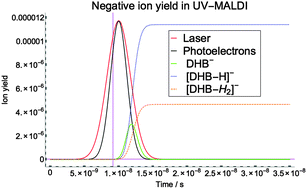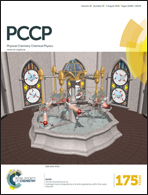Non-linear photoelectron effect contributes to the formation of negative matrix ions in UV-MALDI†
Abstract
The mechanism of negative ion formation in matrix-assisted laser desorption/ionization (MALDI) is less well understood than that of positive ions: electron capture, disproportionation, and liberation of negatively charged sample molecules or clusters have been proposed to produce the initial anions in MALDI. Here, we propose that the non-linear photoelectric effect can explain the emission of electrons from the metallic target material. Moreover, electrons with sufficient kinetic energy (0–10 eV) could be responsible for the formation of initial negative ions. Gas-phase electron capture by neutral 2,5-dihydroxy benzoic acid (DHB) to yield M− is investigated on the basis of a coupled physical and chemical dynamics (CPCD) theory from the literature. A three-layer energy mass balance model is utilized to calculate the surface temperature of the matrix, which is used to determine the translational temperature, the number of desorbed matrix molecules per unit area, and the ion velocity. Calculations of dissociative attachment and autoionization rates of DHB are presented. It was found that both processes contribute significantly to the formation of [M − H]− and [M − H2]−, although the predicted yield in the fluence range of 5−100 mJ cm−2 is low, certainly less than that for positive ions M+. This work represents the first proposal for a comprehensive theoretical description of negative ion formation in UV-MALDI.


 Please wait while we load your content...
Please wait while we load your content...